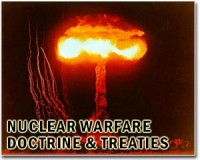 |
United Nations (AFP) May 2, 2010 The Nuclear Non-Proliferation Treaty (NPT), designed to curb the spread of nuclear weapons, comes up for review at a UN conference opening Monday and running through May 28. -- Its key features: . Seen as the cornerstone of the global non-proliferation regime, it requires non-nuclear weapon states that have signed it to refrain from developing nuclear weapons. In exchange, the five nuclear weapon states have pledged to "pursue negotiations in good faith" on disarmament and to provide access to peaceful nuclear energy. . It came into force in 1970 and has been signed by 190 countries, including the five recognized nuclear weapon states: the United States, Russia, Britain, France, and China, the five veto-wielding members of the UN Security Council. North Korea was among those who acceded to the treaty, but violated it and withdrew from it in 2003. . Four non-parties to the treaty are known or believed to possess nuclear weapons. India, Pakistan and North Korea have openly tested and declared that they possess nuclear weapons, while Israel is believed to have some 200 atom bombs but neither confirms nor denies this. . The NPT is based on three main pillars: 1. non-proliferation 2. disarmament, with all NPT signatories urged to move in the general direction of nuclear and total disarmament. 3. the right to peacefully use nuclear technology for all non-weapon countries which can demonstrate that their nuclear programs is not used for military purposes. -- Treaties establishing nuclear weapon-free areas: . Latin American and Caribbean countries created the world's first Nuclear Weapons Free Zone (NWFZ) under the 1967 Tlateloco Treaty. . The South Pacific NWFZ was set up in 1985 under the Rarotonga Treaty. . The Southeast Asia NWFZ was established in 1995 under the Bangkok Treaty . The African NWFZ was set up in 1996 under the Pelindaba Treaty. . Mongolia became a one-state NWFZ in 1992. . Central Asia became a Nuclear-Weapon-Free Zone (CANWFZ) treaty under a 2006 treaty signed in at the Semipalatinsk Test Site, Kazakhstan. . Antarctica also is also a nuclear weapon-free area under a 1959 treaty -- Purpose of the Review conference: Review conferences are held every five years to assess progress on disarmament and tougher monitoring of nuclear programs worldwide. The 1995 review conference extended the treaty indefinitely. THE 2000 review concluded with a pledge to move toward nuclear disarmament while the 2005 conference foundered over disputes over Iran's nuclear program and Israel's being the only Middle Eastern state with atomic bombs. -- ISSUES before next week's review conference: . Although the new US-Russian strategic arms accord setting limits of 1,550 nuclear warheads for each country has injected a note of optimism, developing countries still feel the nuclear weapon states have not done enough on disarmament. This could block progress on things the weapons states want, such as stronger verifications measures and instituting procedures to punish countries which withdraw from the treaty. . Iranian President Mahmoud Ahmadinejad may attend the conference to assert his country's right to conduct uranium enrichment and the Iranians are likely to turn the spotlight on Israel's sizable nuclear arsenal. He would also try to make Iran the champion of the right of developing states to nuclear technology, even sensitive processes such as uranium enrichment which have military as well as civilian applications. . Egypt, backed by non-aligned states, is also asking that the Jewish state should join the NPT and that there should be an international conference on creating a nuclear weapons-free zone in the Middle East. A dispute over this could paralyze the review conference. The United States would like to avoid these disputes and have a final statement that at least reaffirms the NPT principles, even if there are no new concrete measures.
Share This Article With Planet Earth
Related Links Learn about nuclear weapons doctrine and defense at SpaceWar.com Learn about missile defense at SpaceWar.com All about missiles at SpaceWar.com Learn about the Superpowers of the 21st Century at SpaceWar.com
 UN to scrutinize efforts to check nuclear proliferation
UN to scrutinize efforts to check nuclear proliferationUnited Nations (AFP) May 2, 2010 Some 150 countries meet here from Monday to review global efforts to check the spread of nuclear weapons, with the unresolved Iranian nuclear crisis looming large in the background. Iranian President Mahmoud Ahmadinejad, whose country is likely to face fresh UN sanctions over its nuclear defiance, was expected to be among the first to speak at the opening session of the Nuclear Non-Prolifera ... read more |
|
| The content herein, unless otherwise known to be public domain, are Copyright 1995-2010 - SpaceDaily. AFP and UPI Wire Stories are copyright Agence France-Presse and United Press International. ESA Portal Reports are copyright European Space Agency. All NASA sourced material is public domain. Additional copyrights may apply in whole or part to other bona fide parties. Advertising does not imply endorsement,agreement or approval of any opinions, statements or information provided by SpaceDaily on any Web page published or hosted by SpaceDaily. Privacy Statement |